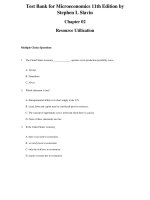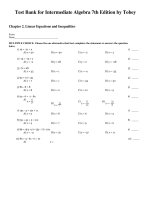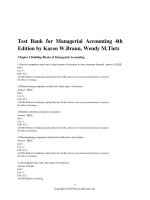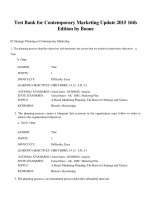link full download test bank for infants children and adolescents 8th edition by berk
Bạn đang xem bản rút gọn của tài liệu. Xem và tải ngay bản đầy đủ của tài liệu tại đây (517.43 KB, 50 trang )
Infants Children and Adolescents: 8th Edition Test Bank – Berk
cHAPTER 6
COGNITIVE DEVELOPMENT
IN INFANCY AND TODDLERHOOD
MULTIPLE CHOICE
1) In Piaget’s sensorimotor stage, infants and toddlers
1.
2.
3.
4.
A) assimilate more than they accommodate.
B) represent their experiences in speech, gesture, and play.
C) ―think‖ with their eyes, ears, hands, and other sensorimotor equipment.
D) solve everyday practical problems and carry out many activities inside
their heads.
Answer: C
Page Ref: 201
Skill: Understand
Objective: 6.1
2) According to Piaget, infants’ very first schemes are
1.
2.
3.
4.
A) disorganized bits of information.
B) based on internal representations of experience.
C) sensorimotor action patterns.
D) deliberate and creative.
Answer: C
Page Ref: 202
Skill: Understand
Objective: 6.1
3) In Piaget’s theory, __________ involves building schemes through
direct interaction with the environment.
1.
2.
3.
4.
A) disequilibrium
B) assimilation
C) organization
D) adaptation
Answer: D
Page Ref: 202
Skill: Remember
Objective: 6.1
4) In Piaget’s theory, during __________, toddlers use their current schemes
to interpret the external world.
1.
2.
3.
4.
A) equilibrium
B) assimilation
C) accommodation
D) organization
Answer: B
Page Ref: 202
Skill: Remember
Objective: 6.1
5) According to Piaget, in accommodation, children
1.
2.
3.
4.
A) build schemes through direct interaction with the environment.
B) create new schemes or adjust old ones.
C) use current schemes to interpret the external world.
D) rearrange schemes, linking them with other schemes.
Answer: B
Page Ref: 202
Skill: Understand
Objective: 6.1
6) At 6 months, Annabelle dropped her rattle in a fairly rigid way. By 12
months, she tossed objects down the basement stairs, bounced them off walls, and
threw them in the air. Annabelle’s modifications of her dropping scheme are an
example of
1.
2.
3.
4.
A)
B)
C)
D)
Answer: A
Page Ref: 202
Skill: Apply
Objective: 6.1
7) When children are not changing much, they
1.
2.
3.
4.
A) are in a state of disequilibrium.
B) assimilate more than they accommodate.
C) experience cognitive discomfort.
D) modify their schemes.
Answer: B
Page Ref: 202
Skill: Understand
Objective: 6.1
8) During times of rapid cognitive change,
1.
2.
3.
4.
A) organization predominates over adaptation.
B) accommodation predominates over assimilation.
C) assimilation and accommodation are balanced.
D) adaptation and organization are balanced.
Answer: B
Page Ref: 202
Skill: Understand
Objective: 6.1
9) In Piaget’s theory, each time the back-and-forth movement between
equilibrium and disequilibrium occurs,
1.
2.
3.
4.
A) children regress to a previous stage of development.
B) less effective schemes are produced.
C) children adapt more than they organize.
D) more effective schemes are produced.
Answer: D
Page Ref: 202
Skill: Understand
Objective: 6.1
10) According to Piaget, organization takes place
1.
2.
3.
4.
A)
B)
C) through direct contact with the environment.
D) when new schemes are formed.
Answer: A
Page Ref: 202
Skill: Understand
Objective: 6.1
11) Baby Franklin practiced his dropping and throwing schemes, and eventually
developed an understanding of height. This achievement is an example of
1.
2.
3.
4.
A)
B)
C)
D)
Answer: A
Page Ref: 202
Skill: Apply
Objective: 6.1
12) In Piaget’s sequence of sensorimotor development, infants first develop
1.
2.
3.
4.
A) mental representations.
B) tertiary circular reactions.
C) reflexive schemes.
D) primary circular reactions.
Answer: C
Page Ref: 203
Skill: Remember
Objective: 6.2
13) In Piaget’s theory, a circular reaction is a means of building schemes in
which infants
1.
2.
3.
4.
A) attempt to form mental symbols of the world.
B) try to repeat chance motor activities again and again.
C) try to imitate the behaviors of others around them.
D) attempt to act out imaginary activities.
Answer: B
Page Ref: 203
Skill: Understand
Objective: 6.2
14) Baby Faith sucks, grasps, and looks in much the same way, no matter
what experiences she encounters. Faith is probably in Substage _____ of
Piaget’s sensorimotor period.
1.
2.
3.
4.
A) 1
B) 2
C) 3
D) 4
Answer: A
Page Ref: 203
Skill: Apply
Objective: 6.2
15) According to Piaget’s theory, when Baby D’Arcy sucks her thumb, she
is demonstrating
1.
2.
3.
4.
A) goal-directed behavior.
B) a primary circular reaction.
C) a secondary circular reaction.
D) a tertiary circular reaction.
Answer: B
Page Ref: 203
Skill: Apply
Objective: 6.2
16) Baby Sabrina opens her mouth differently for a nipple than for a spoon. In
Piaget’s theory, this is an example of a
1.
2.
3.
4.
A) reflexive scheme.
B) primary circular reaction.
C) secondary circular reaction.
D) tertiary circular reaction.
Answer: B
Page Ref: 203
Skill: Apply
Objective: 6.2
17) Baby Andre accidentally knocks a toy hung on his crib. Over the next
several days, Andre tries to repeat this effect, gradually forming a ―hitting‖
scheme. In Piaget’s theory, this is an example of a
1.
2.
3.
4.
A) reflexive scheme.
B) primary circular reaction.
C) secondary circular reaction.
D) tertiary circular reaction.
Answer: C
Page Ref: 203–204
Skill: Apply
Objective: 6.2
18) According to Piaget, __________ first occurs in Substage 4 of
the sensorimotor period.
1.
2.
3.
4.
A) intentional, goal-directed behavior
B) chance behavior
C) repetition of interesting events
D) behavior repetition with variation
Answer: A
Page Ref: 204
Skill: Understand
Objective: 6.2
19) Two landmark cognitive changes that take place in Substage 4 of the
sensorimotor period of Piaget’s theory are __________ and __________.
1.
2.
3.
4.
A) deferred imitation; animistic thinking
B) intentional behavior; object permanence
C) dual representation; intentional behavior
D) deferred imitation; object permanence
Answer: B
Page Ref: 204
Skill: Remember
Objective: 6.2
20) Nine-month-old Daisy retrieves her pacifier, which her mother has
hidden under a cover. Baby Daisy has begun to master
1.
2.
3.
4.
A) deferred imitation.
B) object permanence.
C) make-believe play.
D) reflexive schemes.
Answer: B
Page Ref: 204
Skill: Apply
Objective: 6.2
21) Baby Luigi’s mom shows him his toy turtle, which she has placed behind a
pillow. He reaches for it and finds it several times. Luigi’s mom then shows him
his turtle hidden in a basket. Luigi continues to search for it behind the pillow. This
is most likely because Luigi
1.
2.
3.
4.
A) is not yet able to make an accurate A–B search.
B) does not yet appreciate physical causality.
C) has not yet attained even rudimentary object permanence.
D) cannot yet engage in goal-directed behavior.
Answer: A
Page Ref: 204
Skill: Apply
Objective: 6.2
22) Piaget concluded that babies make the A-not-B search error because
1.
2.
3.
4.
A) they cannot yet coordinate means–end action sequences.
B) appreciation of physical causality has not yet been attained.
C) the ability to engage in goal-directed behavior has not yet developed.
D) they do not have a clear image of the object as persisting when
hidden from view.
Answer: D
Page Ref: 204
Skill: Understand
Objective: 6.2
23) Baby Manny discovered how to use a stick to get toys that were out of reach.
According to Piaget, Manny’s behavior would best be described as a
1.
2.
3.
4.
A) tertiary circular reaction.
B) secondary circular reaction.
C) primary circular reaction.
D) reflexive scheme.
Answer: A
Page Ref: 204
Skill: Apply
Objective: 6.2
24) __________ enable(s) older toddlers to solve advanced object
permanence problems involving invisible displacement.
1.
2.
3.
4.
A) Imitation
B) Reflexive schemes
C) Mental representation
D) Realistic props
Answer: C
Page Ref: 205
Skill: Understand
Objective: 6.2
25) Two-year-old Greta pretends to bake a cake. Greta is demonstrating
1.
2.
3.
4.
A) object permanence.
B) core knowledge.
C) abstract thinking.
D) mental representation.
Answer: D
Page Ref: 205
Skill: Apply
Objective: 6.2
26) Researchers using the violation-of-expectation method may use __________
by exposing babies to a physical event until their looking declines.
1.
2.
3.
4.
A) habituation
B) assimilation
C) accommodation
D) imitation
Answer: A
Page Ref: 205
Skill: Understand
Objective: 6.3
27) Some critics argue that the violation-of-expectation method is flawed because
1. A) it is difficult for observers to discern when babies have habituated to
the familiar event.
2. B) this method cannot be used with young babies or toddlers, who
easily become fatigued.
3. C) babies make only subtle changes to their behaviors when they recover to
a new stimulus.
4. D) it reveals only babies’ perceptual preference for novelty, not
their knowledge of the physical world.
Answer: D
Page Ref: 205
Skill: Understand
Objective: 6.3
28) In a series of studies using the violation-of-expectation method, Renée
Baillargeon and her collaborators claimed to have found evidence for __________
in the first few months of life.
1.
2.
3.
4.
A) assimilation
B) mental representation
C) object permanence
D) equilibrium
Answer: C
Page Ref: 205
Skill: Remember
Objective: 6.3
29) Follow-up research on infant cognitive development suggests that mastery
of object permanence
1.
2.
3.
4.
A) is present in newborns.
B) is not possible until toddlerhood.
C) is a gradual achievement.
D) develops suddenly, at around 4 months.
Answer: C
Page Ref: 207
Skill: Understand
Objective: 6.3
30) Laboratory research reveals that __________ is present at 6 weeks of age.
1.
2.
3.
4.
A) object permanence
B) deferred imitation
C) rational imitation
D) analogical problem solving
Answer: B
Page Ref: 207
Skill: Remember
Objective: 6.3
31) Follow-up research on deferred imitation demonstrates that older infants and
toddlers
1.
2.
3.
4.
A) are more likely to imitate accidental behaviors than purposeful behaviors.
B) can imitate rationally, by inferring others’ intentions.
C) do not yet use intentional means–end action sequences.
D) cannot yet imitate actions that an adult produces.
Answer: B
Page Ref: 208
Skill: Understand
Objective: 6.3
32) When 12-month-old Barrett’s mom asks him, ―Where is your teddy bear?‖
Barrett responds by pointing to the place on his bed where the teddy bear
usually rests. Barrett is displaying
1.
2.
3.
4.
A) habituation and recovery.
B) inferred imitation.
C) displaced reference.
D) means–end problem solving.
Answer: C
Page Ref: 209
Skill: Apply
Objective: 6.3
33) A beginning awareness of the symbolic function of pictures emerges
1.
2.
3.
4.
A) at birth.
B) between 4 and 6 months.
C) in the first year.
D) in the third year.
Answer: C
Page Ref: 209
Skill: Remember
Objective: 6.3
34) Toddlers seem to discount information on video as relevant to their
everyday experiences because
1.
2.
3.
4.
A) the people onscreen do not look at and converse with them directly.
B) they have little experience with digital media.
C) they are easily overstimulated by the fast-paced content.
D) the people onscreen are usually unfamiliar to them.
Answer: A
Page Ref: 210 Box: Social Issues: Education: Baby Learning from TV and Video:
The Video Deficit Effect
Skill: Understand
Objective: 6.3
35) The video deficit effect
3.
4.
5.
6.
A) increases around age 3.
B) is strongest when toddlers view interactive videos.
C) declines around age 2½.
D) is strongest when toddlers view videos rich in social cues.
Answer: C
Page Ref: 210 Box: Social Issues: Education: Baby Learning from TV and Video:
The Video Deficit Effect
Skill: Remember
Objective: 6.3
36) Unlike Piaget, most researchers now believe that
1. A) the cognitive attainments of infancy develop in a neat, stepwise fashion.
2. B) young babies construe all mental representations out of
sensorimotor activity.
3. C) even newborns process information much like adults.
4. D) infants have some built-in cognitive equipment for making sense of
experience.
Answer: D
Page Ref: 211
Skill: Understand
Objective: 6.3
37) Professor Patil believes that babies are born with a set of innate knowledge
systems. Each of these prewired understandings permits a ready grasp of new,
related information and therefore supports early, rapid development. Professor
Patil’s beliefs are consistent with the __________ perspective.
1.
2.
3.
4.
A) nativist
B) core knowledge
C) information-processing
D) social-interactionist
Answer: B
Page Ref: 211–212
Skill: Apply
Objective: 6.3
38) Research involving infants’ numerical knowledge suggests that 6-month-olds
can
1.
2.
3.
4.
A) discriminate quantities up to five.
B) perform simple addition, but not subtraction.
C) distinguish among large sets of items.
D) add and subtract large sets of items.
Answer: C
Page Ref: 213
Skill: Understand
Objective: 6.3
39) The core knowledge perspective emphasizes
1.
2.
3.
4.
A)
B) native endowment.
C)
D)
Answer: B
Page Ref: 213
Skill: Remember
Objective: 6.3
40) Follow-up research on Piaget’s sensorimotor stage yields broad agreement
on which of the following issues?
1.
2.
3.
4.
A) Many cognitive changes of infancy are stagelike.
B) Most aspects of infant cognition develop together.
C) Many cognitive changes of infancy are gradual and continuous.
D) Most aspects of infant cognition develop abruptly.
Answer: C
Page Ref: 213
Skill: Understand
Objective: 6.3
41) In the information-processing system, information first enters
1.
2.
3.
4.
A) working memory.
B) the central executive.
C) long-term memory.
D) the sensory register.
Answer: D
Page Ref: 215
Skill: Remember
Objective: 6.4
42) In the information-processing system, the central executive
1. A) is the conscious, reflective part of the mental system.
2. B) collaborates with long-term memory to direct problem solving and
reasoning.
3. C) is where sights and sounds are represented directly and stored briefly.
4. D) is a special part of the long-term memory that manages
complex activities.
Answer: A
Page Ref: 216
Skill: Remember
Objective: 6.4
43) In the information-processing system, __________ is unlimited in capacity.
1.
2.
3.
4.
A) working memory
B) long-term memory
C) the central executive
D) the sensory register
Answer: B
Page Ref: 216
Skill: Remember
Objective: 6.4
44) __________ controls attention, suppresses impulses, coordinates information in
working memory, and flexibly directs and monitors thought and behavior.
1.
2.
3.
4.
A) Automatic processes
B) Sensory processes
C) Executive function
D) Mirror neurons
Answer: C
Page Ref: 216
Skill: Remember
Objective: 6.4
45) Research on infant attention demonstrates that __________ between birth and
4 to 5 months of age.
1.
2.
3.
4.
A) attraction to novelty increases
B) sustained attention declines
C) habituation time decreases
D) the ability to shift attention declines
Answer: C
Page Ref: 216–217
Skill: Understand
Objective: 6.5
46) The ability to shift attention from one stimulus to another improves by _____
months.
1. A) 2
2. B) 3
3. C) 4
4. D) 6
Answer: C Page
Ref: 217 Skill:
Remember
Objective: 6.5
47) After 2- to 6-month olds forget an operant response,
1.
2.
3.
4.
A) it takes months for them to reinstate the memory.
B) they need only a brief prompt to reinstate the memory.
C) they reinstate the memory after a few days.
D) they are unable to remember it without extensive training.
Answer: B
Page Ref: 217
Skill: Understand
Objective: 6.5
48) Infants learn and retain information
1.
2.
3.
4.
A) only through physical activity.
B) just by watching objects and events.
C) only by manipulating objects.
D) but cannot engage in recall.
Answer: B
Page Ref: 218
Skill: Understand
Objective: 6.5
49) Recall
1.
2.
3.
4.
A) is not as challenging as recognition.
B) is the simplest form of memory.
C) involves remembering a stimulus with perceptual support.
D) improves steadily with age.
Answer: D
Page Ref: 219
Skill: Understand
Objective: 6.5
50) Which of the following statements about infantile amnesia is true?
1. A) Infantile amnesia is more common in females than males.
2. B) Most older children and adults cannot retrieve events that happened
before age 3.
3. C) Infants’ memory processing is fundamentally different from that of
adults.
4. D) During the first few years, children remember largely with
verbal techniques.
Answer: B
Page Ref: 220 Box: Biology and Environment: Infantile Amnesia
Skill: Remember
Objective: 6.5
51) Research indicates suggest that the advent of __________ contributes to
the end of infantile amnesia.
1.
2.
3.
4.
A) an autobiographical memory
B) a clear self-image
C) object permanence
D) mnemonic strategies
Answer: B
Page Ref: 220 Box: Biology and Environment: Infantile Amnesia
Skill: Understand
Objective: 6.5
52) Which of the following statements about categorization is true?
1. A) Even young infants can categorize, grouping similar objects and
events into a single representation.
2. B) As infants approach their second birthday, fewer categories appear to
be based on subtle sets of features.
3. C) Older infants cannot make categorical distinctions when the perceptual
contract between two categories is minimal.
4. D) Not until the early preschool years can children sort people and their
voices by gender and age.
Answer: A
Page Ref: 219
Skill: Remember
Objective: 6.5
53) Korean toddlers develop object-sorting skills later than their Englishspeaking counterparts because
1. A) they are less likely to be given opportunities to physically
manipulate objects.
2. B) English-speaking children develop language skills sooner than Koreanspeaking children.
3. C) the English language is less complex than the Korean language.
4. D) the Korean language often omits object names from sentences.
Answer: D
Page Ref: 221
Skill: Understand
Objective: 6.5
54) The greatest drawback of the information-processing perspective is its
difficulty with
1.
2.
3.
4.
A) breaking down children’s thoughts into precise procedures.
B) putting the components of cognition into a broad, comprehensive theory.
C) analyzing cognition into its components.
D) reducing changes in thoughts into manageable proportions.
Answer: B
Page Ref: 222
Skill: Understand
Objective: 6.6
55) Vygotsky’s sociocultural theory emphasizes that children
1. A) are born with prewired understandings that permit a ready grasp of
new information.
2. B) ―think‖ with their eyes, ears, hands, and other sensorimotor equipment.
3. C) live in rich social and cultural contexts that affect the way their
cognitive world is structured.
4. D) discover virtually all knowledge about the world through their
own activity.
Answer: C
Page Ref: 222
Skill: Understand
Objective: 6.7
56) According to Vygotsky, children master activities through
1.
2.
3.
4.
A) joint activities with more mature members of their society.
B) interaction with the physical environment.
C) operant conditioning and modeling.
D) a complicated system of trial and error.
Answer: A
Page Ref: 222
Skill: Understand
Objective: 6.7
57) Which of the following tasks would be within Lucy’s zone of
proximal development?
1. A) a task that Lucy cannot accomplish alone or with the help of an adult
2. B) a task that Lucy has recently mastered independently following
the assistance of an adult
3. C) a task that Lucy cannot yet handle on her own but can do with the help of
an adult
4. D) a task that Lucy accomplishes through her independent activity
Answer: C
Page Ref: 222
Skill: Apply
Objective: 6.7
58) Three-year-old Liam is putting together a puzzle. Liam’s father begins by
pointing to where each piece needs to go and then straightening out each piece as
Liam places them on the puzzle board. As Liam’s competence with the task
increases, his father gradually withdraws support. This is an example of
1.
2.
3.
4.
A)
B) cooperative learning.
C) reciprocal teaching.
D) transitive inference.
Answer: A
Page Ref: 222
Skill: Apply
Objective: 6.7
59) Which of the following statements about the application of Vygotsy’s ideas
to infancy and toddlerhood is true?
5. A) Vygotsky failed to recognize the significance of social experiences for
children under the age of 5.
6. B) Fine-tuned adult support during infancy and toddlerhood is related
to advanced problem solving during the second year.
7. C) Cultural variations in social experiences rarely affect mental
strategies until children reach school age.
8. D) While scaffolding promotes learning in the preschool years, it seems to
inhibit learning in infancy and toddlerhood.
Answer: B
Page Ref: 223
Skill: Remember
Objective: 6.7
60) Barbara Rogoff’s research using a jack-in-the-box found that as early as the
first year, __________ affect(s) mental strategies.
1.
2.
3.
4.
A) development of cognitive schemes
B) cultural variations in social experiences
C) repetition and training
D) cultural variations in formal schooling
Answer: B
Page Ref: 223
Skill: Understand
Objective: 6.7
61) Which of the following statements is supported by research on make-believe
play?
1. A) Early make-believe is the combined result of children’s readiness to
engage in it and social experiences that promote it.
2. B) In cultures where make-believe play is more frequent with older
siblings than with mothers, the pretend play of toddlers is hindered.
3. C) Most episodes of make-believe play during toddlerhood occur
when children are playing with same-aged children.
4. D) Children are more likely to combine play schemes into complex
sequences when they are playing with agemates than when playing
with caregivers.
Answer: A
Page Ref: 224 Box: Cultural Influences: Social Origins of Make-Believe Play
Skill: Understand
Objective: 6.7
62) Research demonstrates that make-believe play is
1. A) less frequent and rich in collectivist cultures than in
individualistic cultures.
2. B) a major means through which children extend their cognitive and
social skills.
3. C) usually initiated by toddlers rather than by their parents or older siblings.
4. D) discovered by toddlers independently, once they are capable of
representational schemes.
Answer: B
Page Ref: 224 Box: Cultural Influences: Social Origins of Make-Believe Play
Skill: Understand
Objective: 6.7
63) Compared with cognitive theories, mental tests
1. A) focus on cognitive products rather than on the process of development.
2. B) focus on how children’s thinking changes rather than on
cognitive products.









